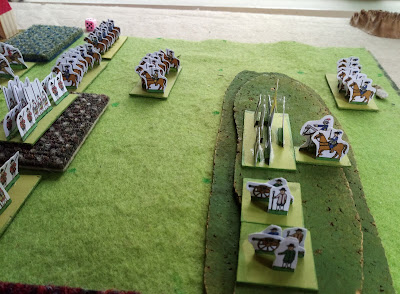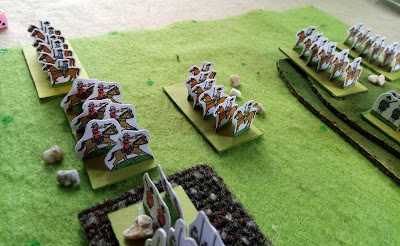Some of it will be that my burlesque activities have continued this year, and have taken up more of my time and, more importantly, attention. This was the year I went solo for the first time, and it's been an amazing experience. All things being well, this will continue in 2020, but maybe I'll get better at juggling gaming with glamour.
Anyway, here's the most popular post in terms of views from each month of 2019. Looking through it there are still some fun games in there, and fond memories, so maybe 2019 hasn't been quite as bad as I make it out to be.
January
Risk: Europe - The post-Christmas sales always turn up some bargains, and this Risk variant was one of them. I bought it not for the game, but for the gorgeous playing pieces. Needless to say after the enthusiastic unboxing and sorting I haven't done anything with them ... yet.
February
Rebels and Patriots - This was probably my favourite new game of the year; a variant of the Rampant system from Osprey it extends the game into the 18th and 19th century 'black powder' era. The focus of the rules is very much the Americas, and our first few games used American Civil War forces.
March
Gunboat Diplomacy - I've found myself going back to Galleys & Galleons a few times this year. Along with HOTT it's becoming one of those games that's easy to get out and set up when I need a quick gaming fix and, whilst terribly random sometimes, always gives an unpredictable and fun experience. This scenario saw a Royal Navy steamship trying to clear out a nest of pirates in the far East and, it has to be said, failing dismally each time I played it.
April
Night Witches - Very occasionally I dabble in role-playing games, and this year saw one of those times. I came across references to the game 'Night Witches' online, was intrigued by the setting and bought it. I ran it for my wife and daughter, and we had a great time, but somehow life has prevented us from taking it any further, which is a shame. It's a game which allows any player to pick up and run the campaign, so I'm keen to continue what we were doing as a player as well as the gamesmaster.
May
Simplicity in Hexes - Simplicty in Hexes was a variant of Neil Thomas's 'Simplicity in Practice' which I picked up off another blog (you know who you are), and very much geared up for a One Hour Wargames style of game. I gave it a try and rather liked it.
June
Daleks, Dinosaurs and Rocketships - Where would this blog be without HOTT? I think every year has seen at least one game of HOT make the annual review, and this year was no exception. This game saw Daleks fighting Flash Gordon, and if that doesn't make you want to click through and read the post then really there's no hope for you.
July
August
Expanded Table for 'Four Against Darkness' - Part 1 - This was probably my one big 'new game' discovery of the year; Ganesha Games' 'For Against Darkness', which is basically a simple pencil-and-paper classic dungeon-crawl game. Because it's designed for solo play it's very easy to tweak and add to, since the only person you're breaking it for is yourself. I took it away on holiday with me and, worried about exhausting the possibilities of the tables in the basic rules. So I made up a few extra ones of my own, and shared them here. People seem to like them.
September
Napoleonic Rebels & Patriots - Back to Rebels & Patriots. This time we used 28mm figures, and played a classic Napoleonics action, just to see how the rules worked in that setting. We thought that they worked very well, and we also got a close and exciting game out of it as French and Austrian troops fought for control of a ruined farm.
October
Frocktober 2019 - Part 1 - Regular readers of this blog will be used to the Frocktober fundraiser posts in October, and the glimpse it gives you of my ever-increasing collection of dresses. I wore twelve different dresses this year, none of which were repeats of the thirteen dresses I wore in 2018's fundraiser. My wife, daughter and I raised over $800 for the Ovarian Cancer Research Foundation. This year I give you a picture if my daughter, rather than one of me.
November
Waterloo: The Prussian Bit - Every year the Gong Garage Gamers do some sort of Waterloo game. Usually we try to do it around June, but this year we ended up doing it later in the year. We used Blucher ended up playing an exciting game based around the Prussian attack on the French right.
December
One-Hour ECW - I've finished off the year with a return to my ECW armies. Mostly I've been playing around with my Portable Wargame variant, but in this game I got out my One-Hour Wargames variant to see if they still gave an interesting game. They do, but at the moment I still think I prefer the Portable Wargame. Maybe the real answer is a mashup of the two, but I haven't quite got there yet.
2020 will still, I suspect, be a compromise between gaming and getting my kit off. I'll make sure that this blog focuses predominantly on the former.




















































